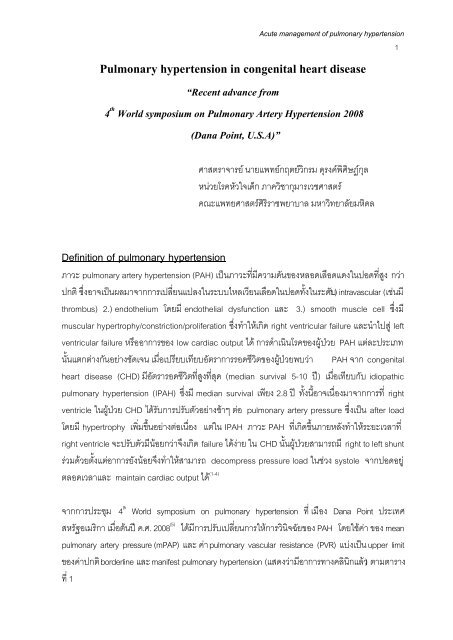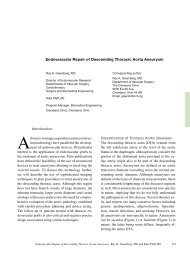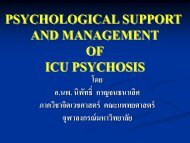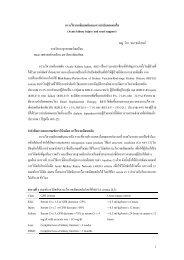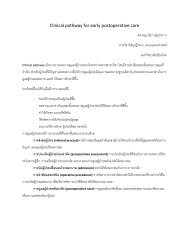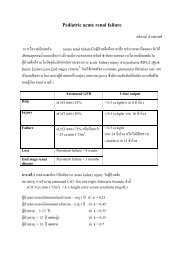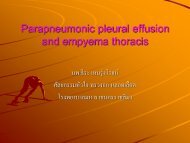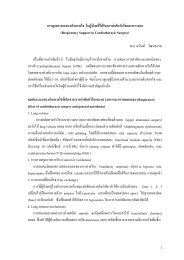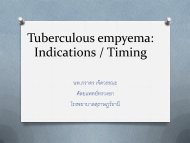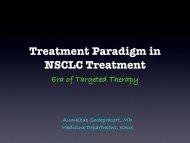Treatment of pulmonary hypertension in congenital heart disease
Treatment of pulmonary hypertension in congenital heart disease
Treatment of pulmonary hypertension in congenital heart disease
Create successful ePaper yourself
Turn your PDF publications into a flip-book with our unique Google optimized e-Paper software.
Acute management <strong>of</strong> <strong>pulmonary</strong> <strong>hypertension</strong>1Pulmonary <strong>hypertension</strong> <strong>in</strong> <strong>congenital</strong> <strong>heart</strong> <strong>disease</strong>“Recent advance from4 th World symposium on Pulmonary Artery Hypertension 2008(Dana Po<strong>in</strong>t, U.S.A)”ศาสตราจารย นายแพทยกฤตยวิกรม ดุรงคพิศิษฏกุลหนวยโรคหัวใจเด็ก ภาควิชากุมารเวชศาสตรคณะแพทยศาสตรศิริราชพยาบาล มหาวิทยาลัยมหิดลDef<strong>in</strong>ition <strong>of</strong> <strong>pulmonary</strong> <strong>hypertension</strong>ภาวะ <strong>pulmonary</strong> artery <strong>hypertension</strong> (PAH) เปนภาวะที่มีความดันของหลอดเลือดแดงในปอดที่สูง กวาปกติ ซึ่งอาจเปนผลมาจากการเปลี่ยนแปลงในระบบไหลเวียนเลือดในปอดทั้งในระดับ 1.) <strong>in</strong>travascular (เชนมีthrombus) 2.) endothelium โดยมี endothelial dysfunction และ 3.) smooth muscle cell ซึ่งมีmuscular hypertrophy/constriction/proliferation ซึ่งทําใหเกิด right ventricular failure และนําไปสู leftventricular failure หรืออาการของ low cardiac output ได การดําเนินโรคของผูปวย PAH แตละประเภทนั้นแตกตางกันอยางชัดเจน เมื่อเปรียบเทียบอัตราการรอดชีวิตของผูปวยพบวา PAH จาก <strong>congenital</strong><strong>heart</strong> <strong>disease</strong> (CHD) มีอัตรารอดชีวิตที่สูงที่สุด (median survival 5-10 ป) เมื่อเทียบกับ idiopathic<strong>pulmonary</strong> <strong>hypertension</strong> (IPAH) ซึ่งมี median survival เพียง 2.8 ป ทั้งนี้อาจเนื่องมาจากการที่ rightventricle ในผูปวย CHD ไดรับการปรับตัวอยางชาๆ ตอ <strong>pulmonary</strong> artery pressure ซึ่งเปน after loadโดยมี hypertrophy เพิ่มขึ้นอยางตอเนื่อง แตใน IPAH ภาวะ PAH ที่เกิดขึ้นภายหลังทําใหระยะเวลาที่right ventricle จะปรับตัวมีนอยกวาจึงเกิด failure ไดงาย ใน CHD นั้นผูปวยสามารถมี right to left shuntรวมดวยตั้งแตอาการยังนอยจึงทําใหสามารถ decompress pressure load ในชวง systole จากปอดอยูตลอดเวลาและ ma<strong>in</strong>ta<strong>in</strong> cardiac output ได (1-4)จากการประชุม 4 th World symposium on <strong>pulmonary</strong> <strong>hypertension</strong> ที่ เมือง Dana Po<strong>in</strong>t ประเทศสหรัฐอเมริกา เมื่อตนป ค.ศ. 2008 (5) ไดมีการปรับเปลี่ยนการใหการวินิจฉัยของ PAH โดยใชคา ของ mean<strong>pulmonary</strong> artery pressure (mPAP) และ คา <strong>pulmonary</strong> vascular resistance (PVR) แบงเปน upper limitของคาปกติ borderl<strong>in</strong>e และ manifest <strong>pulmonary</strong> <strong>hypertension</strong> (แสดงวามีอาการทางคลินิกแลว) ตามตารางที่ 1
Acute management <strong>of</strong> <strong>pulmonary</strong> <strong>hypertension</strong>2ตารางที่ 1 การวินิจฉัยภาวะ PAH โดยใชคา ของ mean <strong>pulmonary</strong> artery pressure (mPAP) และ คา<strong>pulmonary</strong> vascular resistance (PVR) แบงเปน upper limit ของคาปกติ borderl<strong>in</strong>e และ manifest<strong>pulmonary</strong> <strong>hypertension</strong> (แสดงวามีอาการทางคลินิกแลว (6-8)mPAP (mmHG) PVR(unit⋅m 2 )PVR(dynesecUpper limit 20 2 160Borderl<strong>in</strong>e 21-24 2-3 160-240Manifest PAH ≥25 >3 >240โดยในทางปฏิบัติเราใชการวัดคา tricuspid velocity jet หนวยเปน meter/sec (m/sec) จากechocardiography ซึ่งพบวาคาที่มากกวา 2.8 m/sec มีความสัมพันธใกลกับ mPAP ที่ 24.1 mmHG(ตารางที่ 2) การที่ใชคา tricuspid velocity jet เนื่องจากแตละสถาบันอาจใชคา right atrial pressure ที่แตกตางกันตารางที่ 2 คา tricuspid velocity jet เมื่อเทียบกับ Tricuspid <strong>in</strong>stantaneous peak gradient (TIPG) มีหนวยเปน meter/sec (m/sec) และคาความดันที่คํานวณไดคือ <strong>pulmonary</strong> artery systolic pressure (PASP)(6-8)และ mean <strong>pulmonary</strong> artery pressure (mPAP) หนวยเปน mmHG ทั้งหมดCut <strong>of</strong>f(m/sec)TIPG(mmHG)PASP(RA=5)5 )mPAP(mmHG)>2.5 25 30 ∼ 20.3>3 36 41 27>2.8 31 36 24.1
Acute management <strong>of</strong> <strong>pulmonary</strong> <strong>hypertension</strong>3Factors <strong>in</strong>volve natural (or modified) history <strong>of</strong> <strong>pulmonary</strong> <strong>hypertension</strong> <strong>in</strong><strong>congenital</strong> <strong>heart</strong> <strong>disease</strong>เราสามารถแบงปจจัยที่มีผลการแสองออกของผูปวย CHD เปน 2 ประเภทไดแก1. ปจจัยพื้นฐานเดิมที่เชื่อกันทั่วไป1.1) ปริมาณของ left to right shunt หรือ ratio ของ <strong>pulmonary</strong> blood flow ตอ systemic bloodflow (Qp: Qs) ซึ่งรวมถึง <strong>pulmonary</strong> vascular resistance หรือ (ที่เรียกบอยๆวา bed) โดยมีปจจัยที่อื่นๆที่เกี่ยวของเชน อายุ ขนาดของรูรั่ว compliance ของ ventricle ขนาดของ <strong>pulmonary</strong>(9-12)artery1.2) lung <strong>in</strong>jury จากการ on bypass การผาตัดที่ผานมา อาจทําใหเกิด <strong>pulmonary</strong>hypertensive crisis เปนไปไดวาผลกระทบนี้จะทําใหเกิดการเปลี่ยนแปลงของ <strong>pulmonary</strong>vascular bed เลยชวง post operative period เชนมีผูปวยหลายที่ไดรับ การปดรูรั่วแลวแตกลับมีคา <strong>pulmonary</strong> artery pressure และ คา <strong>pulmonary</strong> vascular resistance เพิ่มขึ้นอยางชาๆ จนมีอาการเต็มที่ โดยเฉพาะใน adult <strong>congenital</strong> <strong>heart</strong> <strong>disease</strong> และตองกลับมารักษาใหม1.3) ผูปวยที่มี left sided <strong>heart</strong> lesion หรือ <strong>pulmonary</strong> ve<strong>in</strong> obstruction หรือมีความผิดปกติของ systolic/diastolic function รวมดวย1.4) ความผิดปกติในการสราง precursor ของ endogenous nitric oxide (eNO) เชน L-arg<strong>in</strong><strong>in</strong>e, การเพิ่มขึ้นของระดับความเขมขนของ endogeneous <strong>in</strong>hibitor (dimethyl arg<strong>in</strong><strong>in</strong>e)อยางไมสมดุล , การเพิ่มสูงขึ้นของระดับ circulat<strong>in</strong>g endothel<strong>in</strong> เชนแบบเดียว persistent<strong>pulmonary</strong> <strong>hypertension</strong> <strong>in</strong> neonate (PPHN)2. ปจจัยอื่นที่เริ่มพบวานาจะมีสวนสําคัญ2.1) ชนิด ของ left to right shunt : pretricuspid (Atrial septal defect:ASD) เทียบกับ posttricuspid (Ventricular septal defect : VSD และ patent ductus arteriosus:PDA) โดยพบวากลุมที่เปน post tricuspid shunt เชน VSD มี <strong>pulmonary</strong> <strong>hypertension</strong> เกิดเร็วเพราะเกิดจากshunt ระดับ left ventricle ที่มีความดันที่ systemic อยูแลว ทําใหมี concentric ventricularhypertrophy (จากการที่มี pressure load ทั้ง 2 ventricle) กลุมนี้จะเกิด oxygen saturation ที่ต่ําไดตั้งแตอายุนอยๆ เชน O2 sat 88%-92% ทําใหมีภาวะ hypoxia และ เกิด fibrosis ไดมากจึงทําใหมี RV failure ไดงาย (ภาพที่ 1 และ2) โดยพบวาผูปวย Eisenmenger ที่มี survival แย(12)ที่สุดคือจาก Truncus arteriosus และ PDA สวนกลุม ASD จะเกิดการเปลี่ยนแปลงอยางชาๆเนื่องจาก left to right shunt ผาน atrial level ในสวนที่มี ความดันต่ํากวาและมี volume load ตอright ventricle อยางเดียว จึงเกิด eccentric hypertrophy จึงคลาย IPAH (13)
Acute management <strong>of</strong> <strong>pulmonary</strong> <strong>hypertension</strong>4ภาพที่ 1.1 และ1.2ภาพที่ 1.1 แสดง pathophysiology ชนิด ของ left to right shunt : pretricuspid (Atrial septaldefect : ASD) เทียบกับ post tricuspid (Ventricular septal defect : VSD และ patentductus arteriosus : PDA) โดยกลุมที่เปน ASD มี eccentric hypertrophy ภาพที่ 1.2 สวนกลุมที่เปน VSD มี RV fibrosis มากกวาเพราะ มี hypoxia รวมดวยมากอน และ RV จะมี ลักษณะconcentric hypertrophy (ASD ; atrial defect, VSD : ventricular septal defect, PA:<strong>pulmonary</strong> pressure, RVH: right ventricular hypertrophy, PAP : <strong>pulmonary</strong> artery(13)pressure, RV: right ventricle)ASDVSDNormal PARVH expose to normal PAPremodel<strong>in</strong>g↑PAhigh PAPRV fibrosisEarly hypoxiaRV survive at 40-50Incomplete(eccentric Hypertrophy)Late hypoxia
• 1.3 Unilateral shunt– 1.3.1 follow<strong>in</strong>g surgical shunt– 1.3.2 <strong>congenital</strong> orig<strong>in</strong> <strong>of</strong> one <strong>pulmonary</strong> artery from aorta• 1.4 Comb<strong>in</strong>ation <strong>of</strong> above• 2. Hemodynamic (Qp:Qs)– 2.1.1 Restrictive (pressure gradient)– 2.1.2 Non-restrictive• 3. Direction <strong>of</strong> shunt– 3.1 Predom<strong>in</strong>ant systemic to <strong>pulmonary</strong> shunt– 3.2 Predom<strong>in</strong>ant <strong>pulmonary</strong> shunt to systemic– 3.2 bidirectional shunt• 4.Other associated lesion• 5. Repair– 5.1 unoperated– 5.2 Palliative– 5.3 Repair– 5.4 Residual shunt• 6. IPAH like physiology– 6.1 Small lesion hemodynamic not related to PAH– 6.2 Small residual lesion after surgical repair– 6.3 PAH after successful corrective surgery• PAH left sided <strong>heart</strong> lesionAcute management <strong>of</strong> <strong>pulmonary</strong> <strong>hypertension</strong>6– 1.1 PAH with PCWP < 12 mmHG after successful corrective surgery– 1.2 PAH with trans<strong>pulmonary</strong> gradient > 25 mmHg or– <strong>pulmonary</strong> diastolic pressure – PCWP > 10 mmHg or PVR > 3 unitm2• Partial or total cavo<strong>pulmonary</strong> anastomosis with abnormal PA pressure or PVR caus<strong>in</strong>gfailure <strong>of</strong> the circulation
Classification <strong>of</strong> <strong>pulmonary</strong> <strong>hypertension</strong>Acute management <strong>of</strong> <strong>pulmonary</strong> <strong>hypertension</strong>7ในป ค.ศ. 2008 การแบงชนิดของ <strong>pulmonary</strong> <strong>hypertension</strong>โดยพิจารณาจาก cl<strong>in</strong>ical evolutionและ histopathology (5) และการตอบสนองตอการรักษาโดยจัดให systemic left to right shunt อยูใน Class I : Pulmonary arterial <strong>hypertension</strong> โดยเพิ่ม def<strong>in</strong>ition ของ Class II : Left <strong>heart</strong><strong>disease</strong> อยางชัดเจนโดยแบงออกเปน systolic หรือ diastolic ventricular dysfunction หรือvalvular <strong>heart</strong> <strong>disease</strong> (ซึ่งอาจนํามาใชกับ obstructed <strong>pulmonary</strong> ve<strong>in</strong> ได) และ Other<strong>congenital</strong> <strong>heart</strong> <strong>disease</strong> เชนผูปวย s<strong>in</strong>gle ventricle ที่ไดรับการทําผาตัด Fontan อยูใน Class V: Miscellaneous การจัดแบงแบบใหมนี้ชวยใหสามารถนําวิธีการรักษาโรค PAH ที่มีประสิทธิผลนี้ ไปใชในการรักษาโรค <strong>pulmonary</strong> <strong>hypertension</strong> แบบอื่น ๆ ทั้งในผูใหญและเด็กภาพที่ 2 WHO classification <strong>of</strong> <strong>pulmonary</strong> <strong>hypertension</strong> : Purposed change, (จาก 4 th Worldsymposium on <strong>pulmonary</strong> <strong>hypertension</strong>) (PAH : <strong>pulmonary</strong> artery <strong>hypertension</strong>, CTD :connective tissue <strong>disease</strong>, PPHN : persistent <strong>pulmonary</strong> <strong>hypertension</strong> <strong>in</strong> neonate, PVOD :(5)<strong>pulmonary</strong> veno-occlusive <strong>disease</strong>)WHO classification <strong>of</strong> <strong>pulmonary</strong> <strong>hypertension</strong>Purposed change : Dana Po<strong>in</strong>t 2008Based on cl<strong>in</strong>ical evolution, histopathology, and response to therapy1. Pulmonary arterial <strong>hypertension</strong>• Idiopathic PAH• Heritable :• Drugs and tox<strong>in</strong> <strong>in</strong>duced• Associated with– CTD– HIV– portal <strong>hypertension</strong>– systemic to <strong>pulmonary</strong> artery shunt– Schitosomiasis– Chronic hemolytic anemia• PPHN• 1°Pulmoanary venoocclusive <strong>disease</strong>(PVOD) and <strong>pulmonary</strong> capillaryhemangiomatosis (PCH)2. PH due to left <strong>heart</strong> <strong>disease</strong>• Systolic dysfunction• Diastolic dysfunction• Valvular <strong>disease</strong>3. PH due to lung <strong>disease</strong> and orhypoxemia• COPD• Interstitial lung <strong>disease</strong>s• Sleep-disordered breath<strong>in</strong>g• Chronic exposure to high altitude• Developement abnormalities4. Chronic thromboembolic <strong>pulmonary</strong><strong>hypertension</strong>5. Miscellaneous• Hematologic disorders : myeloproliferativedisorder, splenectomy• Systemic disorders : Vasculitis,scleroderma, <strong>pulmonary</strong> Langerharns cellhistocystosis, LAM, Neur<strong>of</strong>ibromatosis• Metabolic disorder : GSD, Gaucher, thyroid<strong>disease</strong>• Congenital <strong>heart</strong> <strong>disease</strong> other than left toright shunt• Others : Tumoral obstruction, fibros<strong>in</strong>gmediat<strong>in</strong>itis, chronic renal failure ondialysis
4.2 Troprost<strong>in</strong>il : subcutaneous4.3 Epoprostenol : <strong>in</strong>travenous4.4 Beraprost : oralAcute management <strong>of</strong> <strong>pulmonary</strong> <strong>hypertension</strong>9ตารางที่ 3 ACCP (American College <strong>of</strong> chest physician) grad<strong>in</strong>g system ประกอบดวยการใชquality <strong>of</strong> evidence (Good, fair, low หรือ expert op<strong>in</strong>ion) รวมกับ net benefit วาเปน large,(14)<strong>in</strong>termediate, small, non, conflict<strong>in</strong>g หรือ negativeQuality <strong>of</strong>evidenceNet benefit to patient (adjust for risk and based on cl<strong>in</strong>ical assessment )Large Intermediate Small None Conflict<strong>in</strong>g negativeGoodA A B D I DFairA B C D I DLowB C C I I DExpertE/A E/B E/C I I E/Dภาพที่ 3 แผนภูมิแสดง คําแนะนําการรักษา <strong>pulmonary</strong> artery <strong>hypertension</strong> โดยอาศัย ACCP(American College <strong>of</strong> chest physician) grad<strong>in</strong>g system ลําดับที่ควรเลือกใชยาเรียงจากบนลงลางAPAH : associated <strong>pulmonary</strong> artery <strong>hypertension</strong>, CCB : calcium channel blocker, ERA:endothel<strong>in</strong> receptor antagonist , PDE : Phosphodiesterase 5 <strong>in</strong>hibitor, IV : <strong>in</strong>travenous, SC :subcutaneous)
Anticoagulant (E/B) IPAHDiurectics (E/A)Oxygen (E/C)Digox<strong>in</strong> (E/C)Rehabilitation (E/B)PAH Evidence based RxExpert referal (E/A)Acute <strong>pulmonary</strong> vasodilatortest<strong>in</strong>g (E/C for APAH)Acute management <strong>of</strong> <strong>pulmonary</strong> <strong>hypertension</strong>10Avoid excess exertion (E/A)Birth control (E/A)Pyscho=social (E/C)Infection prevention (E/A)iNO(A)IV epoprostenol (B)Inhaled iloprost (C)Class I-IIIYesNoOral CCB (B)Susta<strong>in</strong>edResponseClass I-IIClass IIERA or PDE (A)Class IIIERA (A) or PDE (A)Inhale iloprost (A)SC troprost<strong>in</strong>il (B)IV epoprostenol (A)Class IVIV epoprostenol (A)IV iloprost (C)IV tropost<strong>in</strong>il (C)Inhale iloprost (B)IV iloprost(C)SC troprost<strong>in</strong>il(B)YesNoIV tropost<strong>in</strong>ilBeraprost(C)(C)ERAPDE(B)(B)Cont<strong>in</strong>ue CCB(< 10%)Acute <strong>pulmonary</strong> vasodilator test<strong>in</strong>gการใช agent ของ test<strong>in</strong>g ในคําแนะนํานี้ใหใช <strong>in</strong>hale nitric oxide (iNO) (15,16) เปนหลักโดยได grad<strong>in</strong>g Aสวนการทดสอบโดย epoprostenol หรือ iloprost มี grad<strong>in</strong>g system เพียง B หรือ C มีการศึกษา acute<strong>pulmonary</strong> vasodilator test<strong>in</strong>g โดยใช iloprost ในประเทศไทยโดย อลิสา ลิ้มสุวรรณ (17,18) ในผูปวยCHD จํานวน 18 ราย อายุ 7 เดือน ถึง 13 ป โดยผูปวยจํานวน 13 รายมีการตอบสนองโดยลด PVR จาก9.3 ± 4.6 เปน 4.6 ± 2.7 unit⋅ m 2 (P < 0.001) ขอมูลในตางประเทศก็มีการใชยา iloprost สําหรับ acute<strong>pulmonary</strong> vasodilator test<strong>in</strong>g เชนกัน (19) ทําใหพออนุมานวาผูปวยบางราย iloprost ทําใหเกิดการตอบสนองของ <strong>pulmonary</strong> vascular resistanceการทดสอบ acute vasodilator test<strong>in</strong>g ที่ใหผลบวก หมายถึง คา mPAP และ PVR ลดลง >(20)20% จาก basel<strong>in</strong>e (Sitbon criteria) ในรายที่ cardiac output ไมเปลี่ยนแปลงหรือเพิ่มขึ้น ขอมูลจากรพ ศิริราช ระหวางป ค.ศ. 1995 ถึง 2005 ในผู ปวย <strong>congenital</strong> <strong>heart</strong> <strong>disease</strong> ที่ตองไดรับการผาตัดหัวใจ (21) โดยมี VSD 90 ราย , ASD ราย 85, PDA 40 ราย, DORV 19ราย, CAVC 33 ราย ที่เหลือเปนcomb<strong>in</strong>e lesions หรือ complex รวมเปนผูปวย จํานวน 326 รายโดยมีอายุเฉลี่ย 18.6±20 ป และมีคาสัดสวน <strong>pulmonary</strong> pressure : systemic pressure 0.77±0.3 และผูปวยเหลานี้ไดรับการผาตัดจํานวน261 รายมีคาเฉลี่ย <strong>pulmonary</strong> arteriolar resistance 9.5±6.1 unit⋅m 2 ผูปวยที่ถูกปฏิเสธการรักษาจํานวน 59 รายมีคาเฉลี่ย <strong>pulmonary</strong> arteriolar resistance 30.6±58.5 unit⋅m 2 อัตราตายในกลุมแรก มี6.8% สวนกลุมหลัง 12% (จากการติดตาม 3 ป )ซึ่งก็ชัดเจนวาการคัดกรองผูปวยเพื่อรับการผาตัดอยูที่<strong>pulmonary</strong> arteriolar resistance ประมาณ 9.5±6.1 unit⋅m 2 สําหรับ morbidity ที่เกิดขึ้นนั้นมี ความแตกตางของขอมูลอยางหลากหลายโดยพบวา มี <strong>pulmonary</strong> hypertensive crisis 11 รายจากผูปวยที่
Acute management <strong>of</strong> <strong>pulmonary</strong> <strong>hypertension</strong>11ไดรับการผาตัด 261 ราย (ไมสามารถ predict อัตราตายหรือการเกิด <strong>pulmonary</strong> hypertensive crisisไดดวย ปจจัยเสี่ยงอยางใดอยางหนึ่งหรือหลายอยางรวมกัน) และพบวาในกลุมที่มีการตอบสนองตอacute <strong>pulmonary</strong> vasodilator test<strong>in</strong>g โดย มี <strong>pulmonary</strong> vascular resistance ลดลง นอยกวา 20%จะมีระยะเวลาที่อยูในหออภิบาลหลังผาตัด (ICU time) ถึง 6.6±8.6 วัน เมื่อเทียบกับกลุมที่มี PVRลดลง มากกวา 20% ซึ่งมี ICU time เพียง1.3 ± 1.5 วัน p-value 0.02 และพบวา ในกลุมแรกจะมีระยะเวลาการใชเครื่องชวยหายใจ ventilator time 71.1 ± 17.6 ชั่วโมง เทียบกับกลุมที่ตอบสนองดีกวาโดยใชเวลาเพียง 17.9 ± 36.6 ชั่วโมง p-value = 0.068เมื่อเทียบกับคําแนะนําใหมดังในภาพเราอาจใชขอมูลของการตอบสนองตอ acute <strong>pulmonary</strong>vasodilator test<strong>in</strong>g มาเปรียบเทียบกับผูปวย peri-operative care เชน ใน Class III ผูปวยที่ไมresponse และมีอาการ นาจะเขาไดกับกลุมที่มี <strong>pulmonary</strong> arteriolar resistance ในชวง 9.5±6.1unitm 2 ในการักษาทั่วไปควรเลือกใช iNO สวนยาอื่นอาจใหเพิ่มเชน endothel<strong>in</strong> receptor antagonist(ERA) (OG feed) หรือ Phosphodiesterase <strong>in</strong>hibitor (OG feed) หรือ <strong>in</strong>hale iloprost จะไดประโยชนสูงสุดPredictor สําหรับ endothelial cell <strong>in</strong>juryพบวาจากการทํา lung biopsy ในปอดผูปวย <strong>congenital</strong> <strong>heart</strong> <strong>disease</strong> ที่เปน irreversible สําหรับการผาตัดหัวใจมี hyperproliferative endothelial phenotype และมี active neoangiogenesis และสามารถใช marker ของ endothelial cell damage (22) เชน Circulat<strong>in</strong>g endothelial cells (CECs) โดยใชวิธีImmunocapture <strong>of</strong> CECs จาก whole blood ที่ at 4°C และใช magnetic beads (Dynabeads M-450, Dynal, Invitrogen, Carlsbad, California, U.S.A.) coated ดวย S-Endo 1 (Biocytex, Marseille,France) หรือใช สวน CD34_ CD133_ population ของ circulat<strong>in</strong>g progenitor cells (CPCs) ที่มาจากไขกระดูก ซึ่งแสดงถึง hematopoietic และ endothelial mobilization capacity ทั้ง CEC และ CPCcounts, แสดงถึง endothelial lesions, repair, ใชประมาณ <strong>in</strong>dividual vascular competence ในirreversible PAH complicat<strong>in</strong>g <strong>congenital</strong> <strong>heart</strong> <strong>disease</strong>Peri-operative medical managementsevere <strong>pulmonary</strong> <strong>hypertension</strong> หรือ <strong>pulmonary</strong> hypertensive crisis ในกลุม CHD (ซึ่งประกอบดวยคา mPAP ที่เพิ่มขึ้นและมี low cardiac output รวมทั้ง oxygen desaturation) ที่มีอาการ
Acute management <strong>of</strong> <strong>pulmonary</strong> <strong>hypertension</strong>12เชน ชวง early post-operative period อาจเกิดรวมกับ severe right ventricular failure ซึ่งใชในกรณีtwo ventricle repair และ มี systemic left ventricle ที่ไมมี right to left shunt (residual shunt)หลงเหลืออยูสําหรับ s<strong>in</strong>gle ventricle physiology (23,24,25) การวินิจฉัยภาวะ <strong>pulmonary</strong> <strong>hypertension</strong> ของผูปวยที่ไดรับการผาตัด bidirectional cavo<strong>pulmonary</strong> anastomosis (BDPCPA แตนิยมเรียกเปนที่เขาใจในปจจุบัน วา Glenn เปนการผาตัดเพื่อนําเลือดจาก superior vena cava ; SVC ตอไปยัง <strong>pulmonary</strong>artery โดยตรง) ทําให ปริมาณ <strong>pulmonary</strong> blood flow (PBF) มีความสัมพันธกับ cerebral blood flowเพราะ เปน preload ของ BDCPA คา trans<strong>pulmonary</strong> gradient ที่ควรจะเปนจะอยูในระดับ 5-10mmHG โดยมี คา mPAP หรือ central venous pressure CVP) ที่ใกล 15 mmHg คาที่สูงกวานี้แสดงถึงภาวะ <strong>pulmonary</strong> <strong>hypertension</strong> (Class V : ตาม guidel<strong>in</strong>e ใหม) การควบคุม PBF อาจใชการทําcontrol hypoventilation ที่ PCO 2 45-50 mmHG เพื่อเพิ่ม cerebral vasodilatation และทําใหมีpreload ที่ดีขึ้นเพื่อเพิ่ม PBF และทําให oxygen saturation ดีขึ้นการผาตัด modified Fontan ซึ่งมีvenous return ที่มาจากทั้ง SVC และ <strong>in</strong>ferior vena cava (IVC) การใช hypoventilation จะมีผลนอยกวา แตคาmPAP มากกวา 15 mmHg ก็ถือวามีภาวะ <strong>pulmonary</strong> <strong>hypertension</strong> และเพิ่มทั้ง morbidityและ mortality มีรายงานการใช <strong>pulmonary</strong> vasodilator ในผูปวยนี้เชน iNO หรือยาในกลุม PDE สวนการใช iloprost ยังไมมีขอมูลที่ยืนยันชัดเจนในชวง acute phase วัตถุประสงคหลักคือการปองกันผลขางเคียงจาก PAH ที่สูงขึ้นจนทําให LV pre loadลดจาก <strong>pulmonary</strong> venous return ที่ลด หรือ RV after load ที่เพิ่ม ซึ่งเปนสาเหตุของ low cardiacoutput จุดมุงหมายในการรักษาผูปวยเหลานี้คือการเพิ่ม cardiac output (LV preload) และการลด rightventricular after load เพื่อ ปรับ <strong>in</strong>terventricular dependence ใหไดขึ้น survival ของผูปวยขึ้นกับ การma<strong>in</strong>ta<strong>in</strong> cardiac output (ตองมี central venous pressure, <strong>pulmonary</strong> artery l<strong>in</strong>e และ left atriall<strong>in</strong>e) อาจใช Swan Ganz catheter ในการ monitor <strong>pulmonary</strong> artery pressure (PAP) หรือ mixvenous blood O2 saturation เพื่อใหประเมิ น cardiac output ซึ่งในทางปฏิบัติมีผูปวยที่ไดรับการmonitor ครบทุกตําแหนงแบบนี้มีเพียงสวนเดียว ทําใหการดูแลผูปวยหลังผาตัดทําไดยาก การใชechocardiography มักใหผลที่ขัดแยงกับสภาวะของผูปวยบอยครั้งหรือ underestimate <strong>pulmonary</strong>artery pressure เพราะไมไดวัด mPAP แตวัด tricuspid regurgitation jet velocity เพียงอยางเดียว แตคา right atrium pressure ที่อาจสูงถึง 20-25 mmHg ก็จะทําใหเรา underestimate <strong>pulmonary</strong> arterypressure ไดงาย และเนื่องจากขอจํากัดของ acoustic w<strong>in</strong>dow ที่ไมดีหลังการผาตัดทําใหการวัดคาตางๆทําไดยาก ไมควรยึด echocardiography เปน เครื่องมือหลักในการ monitor เพราะ over หรือunderestimate ไดงายและทําให เสียเวลาในการแปรผลหรือ mislead<strong>in</strong>g ไดบอย อยางไรก็ตาม
Acute management <strong>of</strong> <strong>pulmonary</strong> <strong>hypertension</strong>13echocardiography นาจะมีประโยชนในการบอก residual defect ไดสวน systolic function นั้นขึ้นกับภาวะ preload/after load มาก การรักษาความดันโลหิตทางรางกายเพื่อทําใหมี coronary perfusionpressure ที่ เพียงพอก็ชวย ทําให ventricular pump<strong>in</strong>g ที่ดีขึ้น ในบทความนี้จะกลาวถึงการใชยาสําหรับรักษา peri-operative management ใน <strong>pulmonary</strong> <strong>hypertension</strong> โดยไมรวมถึงการดูแล supportivemanagement อื่นการใหยาแบบสูดดม (Inhaled Medication)Inhaled Nitric oxide (iNO)ยา iNO แบบสูดดมจะใหผลในการขยายหลอดเลือดปอดเนื่องจาก gas สามารถแพรเขาไปใน<strong>pulmonary</strong> resistance vessels และกระตุนเอนไซม guanylyl cyclase, cyclic guanos<strong>in</strong>emonophosphate (cGMP) ซึ่งมีผลโดยตรงทําใหหลอดเลือดขยายตัว NO จะจับกับ haemoglob<strong>in</strong> ทันทีที่เขาสูกระแสเลือด ดังนั้น จึงชวยลดความเสี่ยงในการเกิด systemic side effect และมีผลโดยตรงตอปอดเทานั้น การใชยา iNO แบบสูดดม (<strong>in</strong>halation) ในเด็กไดเริ่มในผูปวย persistent <strong>pulmonary</strong><strong>hypertension</strong> <strong>of</strong> the newborn (PPHN) จากนั้นจึงมีการนํามาใชในผูปวย CHD (15-16) และยังมีการศึกษาที่แสดงใหเห็นวาผูปวยเด็กที่ตองไดรับการผาตัดหัวใจมีปจจัยเสี่ยงที่ทําให ตองใช iNO คือ อายุนอยกวา1 ป, Down’s syndrome, preoperative <strong>pulmonary</strong> <strong>hypertension</strong>, หรือ <strong>pulmonary</strong> vascularresistance.ภาพที่ 4 หนาจอเครื่อง nitric oxide โดยสามารถปรับปริมาณตั้งแต 0-80 part per million (ppm) โดยScale สวนที่คาต่ํากวา 20ppm จะละเอียดกวา เพื่อประโยชนในการ wean <strong>of</strong>f คาอื่นๆที่ ตอง monitorไดแก O 2 และ nitrogen dioxide (NO 2 ) ซึ่งเปน toxic substance
Acute management <strong>of</strong> <strong>pulmonary</strong> <strong>hypertension</strong>14การใช iNO อาจทําใหเกิดปญหา เชน ความเปนพิษ , rebound phenomenon และพบผูปวยบางกลุมไมตอบสนองตอการรักษาอยางมีนัยสําคัญ (non responder phenomenon) ซึ่งอาจเกิดจากการที่exogenous nitric oxide นั้น อาจไมสามารถออกฤทธิ์ไดเทียบเทากับ endogenous nitric oxide ในตัวเองในบางครั้งจึงอาจตองพิจารณาใหยาอื่น เชน PDE รวมดวย (26,27,28) การใชยา iNO อาจทําใหมี อาการขางเคียงที่เกิดขึ้นจากการรักษาผูปวยในระยะยาว โดย NO ที่เปนอนุมูลอิสระ จะเกิดปฏิกิริยากับ oxygenอยางรวดเร็ว เกิดเปน NO 2 ซึ่งมีพิษ นอกจากนั้นยังทําปฏิกิริยากับ superoxide anions ในระหวางที่มีการอักเสบ (<strong>in</strong>flammatory physical processes) ทําใหเกิด peroxynitrite เปนสาร ที่มีพิษสูง ซึ่งระบบภูมิคุมกันโรคใชในการทําลายจุลินทรียและยังจําเปนสําหรับการปองกันเชื้อ leis mania ในขณะเดียวกันperoxynitrite ยังมีอันตรายตอระบบรางกาย และยับยั้ง เอนไซม prostacycl<strong>in</strong> syntheses ซึ่งเปน enzymeสําหรับสังเคราะห prostacycl<strong>in</strong> NO ยังมีคุณสมบัติกัดกรอน(corrosive gas) อีกดวยการเกิด rebound phenomenon เปนปญหาสําคัญเมื่อนํา NO มาใชในทางปฏิบัติ พบการเกิด<strong>pulmonary</strong> pressure และ resistance เพิ่มขึ้นอยางทันทีหลังจากหยุดการให NO ชนิดสูดดมมานานมากกวา 30 นาที หรืออาจเกิดหลังจากลดยา iNO เปนวัน ๆ ก็ได ปรากฏการณที่เกิดขึ้นนี้อาจทําใหเปนอันตรายถึงชีวิตและเปนสาเหตุทําใหเกิดอาการแทรกซอนที่อันตราย ซึ่งการลด iNO ลงอยางชาๆ (เชนทีละ0.5-5 ppm ทุก 1-2 ชั่วโมง หลังจากที่ขนาด iNO < 20 ppm) หรือเริ่มใชยา sildenafil ในชวง wean <strong>of</strong>fdose
Acute management <strong>of</strong> <strong>pulmonary</strong> <strong>hypertension</strong>15ตารางที่ 4 คําแนะนําในการ wean <strong>of</strong>f iNO โดยอาจใชรวมกับการให sildenafil หรือ iloprost(26)รวมดวยเพื่อปองกันการ rebound (ppm: part per million)iNO Dose Range atWean Initiation, ppmIncrementDecrease, ppmDose Wean Frequency,Hours20 – 40 5 1-210 – 20 2 1-22 – 10 1 1-20 – 2 0.5 1-2Inhaled prostanoids(27)iloprost เปนยาที่มีคุณสมบัติแตกตางจาก epoprostenol และ nitric oxide โดยที่มี half life ที่ยาวกวา 6จึงทําใหมีความสะดวกแก ผูปวยที่จะใชประจําในแตละวันมากขึ้น ยาที่จะใชจะผานเครื่องพนยาที่มีละอองฝอยขนาด 3-5 µm โดยตองมีความสม่ําเสมอของขนาดละอองตลอดเวลาที่พน ขนาดยา ถาใชสําหรับcont<strong>in</strong>uous <strong>in</strong>travenous drip คือ 1-5 ng/kg/m<strong>in</strong> (ขยาดยามากที่สุด 10 ng/kg/m<strong>in</strong>) ซึ่งมีขนาดต่ํากวาการใช IV epoprostenol มาก เมื่อเปรียบเทียบกับ cont<strong>in</strong>uous epoprostenol วาตองใชใน ขนาด10–50ng/kg/m<strong>in</strong> จึงทําใหมี side effect นอยกวา ความแตกตางอยางมากของขนาดยาที่ใชนี้ อาจเนื่องจากiloprost มี potency สูงกวา epoprostenol ประมาณ 5 เทา และจากวิธีการใหยาที่แตกตางกันดวย ในผูปวยบางรายที่มีปญหาการใหยา iloprost ทาง <strong>in</strong>halation อาจใช cont<strong>in</strong>uous drip โดยทาง peripheralIV หรือเพื่อการเฝาติดตามการรักษาที่ดีอาจใช Swan Ganz catheter ในการ monitor <strong>pulmonary</strong> arterypressure (PAP) หรือ mix venous blood O 2 saturation เพื่อใหประเมิ น cardiac output ไดดวย ขนาดยาสําหรับผูปวย acute ที่แนะนําในการสูดแตละครั้งในผูใหญคือ 5–10 µg at mouth piece หรือในเด็กให(29,30)0.5 µg/kg/dose (maximum = 3 µg/kg/does)เครื่องพนละอองยา iloprost ที่ใชในประเทศไทยหลักการใช aerosol therapy คือ การใหยาที่เปนสวนผสมของ solid particles และ liquiddropletผานไปที่ bronchial mucosa โดยปริมาณยาที่สามารถผานเขาไปไดขึ้นอยูกับขนาด aerosolparticles ซึ่งโดยปกติจะใช mass median aerodynamic diameters (MMAD) ตั้งแต 0.8 ถึง 5 µ (คาที่ดี
Acute management <strong>of</strong> <strong>pulmonary</strong> <strong>hypertension</strong>16ควรอยูระหวา 3-5 µ โดยถาขนาดใหญกวานี้จะติดอยูที่ oropharynx ขนาดที่เล็กไปก็จะ bounce ออกมาที่ upper respiratory airway ไมเขาไปที่ <strong>in</strong>terstitialขอดีของการให aerosol therapy คือ1. ออกฤทธิ์ไดเร็วในขนาดยาที่ต่ํากวา2. ยาซึมผาน lower respiratory trace ไดเร็ว3. ใชงานไดงายและมี side effect ที่นอย4. ทําใหทางเดินหายใจมีความชุมชื้นNebulizer (ภาพที่ 5)คือ สวนของอุปกรณที่ใชเปนตัวผสม solid particles และ liquid droplet โดยอาจใชตัวอัดอากาศ(compressor unit) ที่ทําใหยากลายเปน droplet โดยยาจะผานเขาไปใน nebulizer โดยอาศัย venturieffect คือ อากาศที่ถู กอัดผานทอขนาดเล็กทําใหความดันที่ลดลง จะดูดเอายาที่เปนของเหลวผานเขาที่สวนกระเปาะดานลางและวิ่งผานตัวกรองที่ทําใหขนาดเล็กลง nebulizer ที่ใชระบบ ultrasonic จะประกอบไปดวย pyezoelectrice crystal (สวนที่เปนตัวสั่นสะเทือน ) ที่สวนลางของกระเปาะซึ่ง เมื่อไดรับความถี่ขนาด 1 MHz จะทําใหเกิดคลื่น ultrasound ที่มีแรงผลักมากกวาแรงยึดโมเลกุลของยา จึงทําใหยาแยกออกเปน droplet ที่เล็กลง และจะพนผานเขาไปในรูป aerosolชนิดของ ultrasonic unit แบงเปนs<strong>in</strong>gle chamber ยาจะกระทบกับสวน piezoelectric โดยตรง และ double chamber ซึ่งยาจะถูกเทลงดานบนของกระเปาะและมีแผนฟลมบาง แยกชั้นกับสวน piezoelectric transducer โดยจะมีน้ําสัมผัสกับสวน pyezoelectrice crystal ทางดานลางของกระเปาะเพื่อลดปญหาเครื่องรอนไดเครื่องพนยา Opt<strong>in</strong>eb ® และ Omron ® จะใชระบบultrasonic จะเล็กและเงียบกวา เครื่อง Delph<strong>in</strong>us ® ที่เปนชนิด compressor เครื่องทั้งสาม ตองใชสวนผสมของยาในขนาด 3 ml สวนเครื่อง ultrasonic จะใชขนาด 5 ml (แตในทางปฏิบัติผูเขียนใชขนาด 3 ml ทั้งสองชนิด) เครื่องพนทุกชนิดจะมี residual volumeประมาณ 0.5 ถึง 0.8 ml หลังจากที่ใชเวลาพนจน ควันละอองจางหมดไปประมาณ 10 นาที โดยมีระดับของยาที่ปลาย mouth piece แตกตางกันโดย ทั้งสามชนิดจะมีขนาดของ particles ที่นอยกวา 5 µ ในระดับมากกวา 80% ขนาดยา ที่ mouth piece จะอยูในขนาด 2.5-5 µg ในผูใหญและ 0.5 µg/kg/doseโดยมี total dose ที่ 3 µg/kg/day ในเด็ก
Acute management <strong>of</strong> <strong>pulmonary</strong> <strong>hypertension</strong>17ABC
Acute management <strong>of</strong> <strong>pulmonary</strong> <strong>hypertension</strong>18Dภาพที่ 5 เครื่องพนยาชนิดตางๆ A: Delph<strong>in</strong>us ® (air compressor) , B: Opt<strong>in</strong>eb ®และ C : Omron ® (ultrasonic) และ D: iNeb (adaptive aerosol delivery)เครื่องที่ใชบอยในชวง peri-operative management ใน <strong>pulmonary</strong> <strong>hypertension</strong> คือDelph<strong>in</strong>us ® ซึ่งเปน air compressor มีขนาด MMAD ที่ 2.9 µ แตมี aerosol output ที่ต่ําในชวง 30-40% แลวแตการหายใจ การใชเครื่องนี้อาจทําใหสับสนวาสามารถใชเครื่องพน aerosol ชนิด compressorแบบอื่นได (เชนเครื่องพนยา albuterol สําหรับ asthma) ซึ่งเปนการใหยาที่ไมมีประสิทธิภาพเนื่องจากขนาด MMAD ที่ไมเทากัน Opt<strong>in</strong>eb ® ผลิตโดยบริษัท NEBU–TEC med. ประเทศเยอรมนี เปนเครื่องที่ใช ultrasonic system ในการทําละอองยา สามารถใหละอองยาที่มีขนาดอนุภาคแตกตางกันขึ้นกับการเลือกใชชิ้นสวนในการควบคุมการไหลของละอองยา (baffle plates)สําหรับยา iloprost สามารถเลือกใชgreen baffle plates ซึ่งใหขนาดละอองยาที่ MMAD 2.5 µm หรือ blue baffle Plates ซึ่งใหขนาดละอองยาที่ MMAD 3.3 µm สามารถตั้งโปรแกรมการทํางานโดยขนาดยาที่ผูปวยจะไดรับ จะขึ้นกับระยะเวลาการทํางานของเครื่องโดยสามารถใหยาหมดภายใน 3-5 นาที บางรุนตั้งไดถึง 6 โปรแกรมสามารถใชไดกับผูปวยที่สามารถหายใจไดเอง หรือขณะใชเครื่องชวยหายใจ หรือในเด็กเล็กที่ถูก sedateและหายใจเองไมได โดยใชอุปกรณตอเสริมที่เหมาะสม ขอจํากัดคืออุปกรณนี้ไมสามารถคํานวณปริมาณของยาที่แนนอนไดถามีการผสมยา iloprost เพื่อแบงใชอยางที่ทําในประเทศไทย สวนเครื่อง Omron ® ใชหลักการของ ultrasonic nebulizer โดยมีขนาดเล็ก สามารถพกพาได สะดวกโดยใหขนาด MMAD ที่ 1.7µm เทียบไดกับเรื่อง iNeb ใชเวลาในการใหยา 3.4 และ 6.1 นาทีสําหรับการใหยา 1 และ 2 ml ตามลําดับก็ไดถูกนํามาใชอยางไรก็ตามเครื่องทั้งหมดนี้ก็ยังมี effective output เพียง 50-60% เพราะไมไดเปลี่ยนขนาดยาที่พนตามการหายใจ
เครื่องพนยาชนิด adaptive aerosol delivery (AAD)Acute management <strong>of</strong> <strong>pulmonary</strong> <strong>hypertension</strong>19ปจจุบันไดมีการนําเขาเครื่อง I-neb third generation AAD (Adaptive Aerosol Delivery) system ซึ่งมีขนาดเล็ก และ เงียบ การเกิด aerosol อาศัยหลัก VMT (vibrat<strong>in</strong>g mesh technology หมายถึงการเกิดaerosol คลาย ultrasonic แตควบคุมพลังงานทําใหสงปริมาตรของ aerosol ไดแปรเปลี่ยนตามความเร็วหรือจังหวะการหายใจ ) และควบคุมขนาดโดยใช AAD Disc (2.5 หรือ 5 mcg) โดยสามารถใชกับยาVentavis (20mcg/2ml) ไดดีเพราะขนาดการใหยาที่ปริมาตร ไดตั้งแต 0.25 ถึง 1.4 ml. โดยมี residualvolume เพียง 0.1 ml โดยภาพรวมสามารถใหยาไดถึง 50-80% ของแตละครั้งการหายใจโดยเฉลี่ยการหายใจ 3 cycles สุดทายและแปรเปลี่ยนไปไดเรื่อยๆ ระหวางการหายใจจะมีสัญลักษณบอกถึงลักษณะการหายใจของผูปวยทําใหผูปวยปรับเปลี่ยนได เครื่องนี้ถูกออกแบบมาใชใน chronic treatment แตการใชใน acute sett<strong>in</strong>g มีขอไดเปรียบที่เปนเครื่องที่มี effective output ทําใหไดยาในปริมาณที่ ดีที่สุด (60%ขึ้นไป)มีการศึกษา เบื้องตนที่ ร.พ. ศิริราชในผูปวย 15 รายที่ไดรับการผาตัด หรือปดรูรั่วระหวางผนังกั้นหองหัวใจทางการสวนหัวใจ และยังมี <strong>pulmonary</strong> artery pressure มากกวา 75% systemic Pressure โดยที่มีอาการของ congestive <strong>heart</strong> failure หรือ respiratory failure อยู ผูปวยเหลานี้ไดรับการรักษาโดยใชiloprost ขนาด 5–10 µg วันละ 4–6 ครั้ง ขนาดยาในเด็กคือ 0.5 µg/kg/dose หรือ 3 µg/kg/day พนเปนระยะเวลา 48–72 ชั่วโมงโดยพบวาผูปวยทั้งหมด ยกเวน 2 รายไดรับการ extubation โดยที่มีคา oxygensaturation เพิ่มขึ้นอยางชัดเจน จาก 85.8 + 8.1% เปน 93.3 + 5.5% และสามารถลดปริมาณ FiO 2 ไดจนเปน room air ในเบื้องตนพอจะสรุป ไดวายานี้มีที่ใชในผูปวยที่มีอาการอยางรุนแรง การที่ยานี้ทําให O 2saturation สูงขึ้นไดอาจ เกิดจากการที่ยาออกฤทธิ์ vasodilat<strong>in</strong>g effect ในสวนของปอดที่มีการ ventilateไดดีจึงทําใหมี vasodilator effect มากกวาสวนอื่นโดยเกิดจากเลือด shift ไปยังปอดสวนที่ ventilate ไดมากกวา ทําใหมี <strong>pulmonary</strong> blood flow ที่เพิ่มขึ้นเปรียบเทียบกับ area ที่มี ventilation ดีขึ้น เปนการstabilize ภาวะ ventilation perfusion mismatch (V/Q) ไดทําใหมี oxygenation ที่ดีขึ้นมากจึง นาจะ(17-18,26,28)เปนขอไดเปรียบที่สําคัญของยานี้นอกจากนี้อาจใชยานี้รวมกับ iNO เพื่อลด reboundphenomenon หรือรวมกับ PDE เพื่อเพิ่มระยะเวลาออกฤทธิ์ของ iloprost เนื่องมาจากมีการใชยาที่มีราคาแพงSildenafilการใช iNO นั้นมีผลตอการเพิ่มขึ้นของ smooth muscle <strong>in</strong>tracellular cyclic guanos<strong>in</strong>e(cGMP) จึงทําใหมี <strong>pulmonary</strong> vasodilation แตฤทธิ์ที่สั้นของ cGMP เกิดจาก การทําลายโดยPhosphodiesterase (PDE) โดยชนิดที่ 5 นั้นเปน is<strong>of</strong>orm ที่พบมากที่สุดในปอด การยับยั้งการทํางานของ PDE นั้นเปรียบไดเหมือนกับ มี endogenous nitric การทดลองโดยใช i.v sildenafil ในขนาด
Acute management <strong>of</strong> <strong>pulmonary</strong> <strong>hypertension</strong>20ตั้งแต 0.025-0.33 mg/kg โดยเปรียบเทียบกับ iNO ในขนาด 20 ppm และการใหออกซิเจน (FiO 2 =0.65)พบวา การให ออกซิเจน นั้นเปน potent <strong>pulmonary</strong> vasodilator เนื่องจากผลตอ <strong>pulmonary</strong> vascularsmooth muscle และยังสามารถลดผลของ hypoxic vasoconstriction secondary จาก ‘post-pump’parenchymal lung changes ในผูปวยหลังผาตัดหัวใจ the postoperative groupในผูปวยกอนการผาตัดนั้น IV sildenafil (31) สามารถลด PVR ไดเทียบเทากับ iNO แตในผูปวยหลังผาตัด sildenafil ทําใหเกิด <strong>pulmonary</strong> vasodilation ที่มากจนทําใหมี VQ mismatch จาก<strong>in</strong>tra<strong>pulmonary</strong> shunt<strong>in</strong>g ไดและมี คา PO 2 ที่ต่ําลง และมีความดันโลหิตที่ต่ําลงเล็กนอย จึงอาจจะตองระวังในการใชยา sildenafil หลังการผาตัดทันทีโดยยาอาจมีประโยชนในการใชในผูปวยหลังผาตัดหัวใจแลวหลายวัน (ที่ไมมีปญหา hypoxia แลว)ภาพที่ 6 แสดง <strong>pulmonary</strong> vascular resistance <strong>in</strong>dex (PVRI) โดยเปรียบเทียบผลการทดสอบในหองตรวจสวนหัวใจ (cath lab) กับหลังการผาตัด โดยใน cath lab กับ การให ออกซิเจน O 2 , iNO 20 ppm(NO) ยา sildenafil ในขนาด 0.25 mg/kg (S 1 ), 0.33 mg/kg (S 2 ) สวนหลังการผาตัด ให ออกซิเจน O 2(FiO 2 =0.65), iNO 20 ppm (NO) ยา sildenafil ในขนาด 0.025 mg/kg (S 1 ), 0.1 mg/kg (S 2 ) 0.25 mg/kg(S 3 ) (31)
Acute management <strong>of</strong> <strong>pulmonary</strong> <strong>hypertension</strong>21ภาพที่ 7 แสดง mean arterial blood pressure (MAP) จาก systemic blood pressure (เสนบน) และmean <strong>pulmonary</strong> artery pressure (เสนลาง) โดยเปรียบเทียบกับ การให ออกซิเจน O2 , iNO (NO) ยาsildenafil ในขนาด (0.025 mg/k) S 1 , 0.1 mg/kg (S 2 ) 0.25 mg/kg (S 3 ) (31)การใช Sildenafil รวมกับ iNOการใช sildenafil รวมกับ iNO นั้นพบ hypotension ได 3 % มีการทดลองพบถึงความเปนไปไดที่ในการใชPDE <strong>in</strong>hibitor รวมกับ <strong>in</strong>haled iloprost ในผูปวย Eisenmenger (26) โดยจะชวยใหระยะเวลาในการใชยาพนยาแตละครั้งยาวนานขึ้นมาก ชวยให ผูปวยสะดวกขึ้นและสามารถลด คาใชจายลงได การใชยา ผูเขียนมักใชยานี้ในขนาด 50 mg เริ่มตน ครึ่งเม็ด หรือ 0.25 mg/kg/dose จนมากถึง 6-10 mg/kg/dose ก็มีการใชกัน วันละ 2-3 หนโดยใหขนาดสูงสุดวันละ 150-200 mg และใชยารวมกับ beraprost sodium และiloprost ในระยะหลังแพทยบางรายก็ยังสนับสนุนการใชยา (ขอมูลจากการประชุม Update on Cardiac<strong>in</strong>tensive care for Neonates, Children and Young Adults : Shanghai 8-11 มิถุนายน พ.ศ. 2548 :update <strong>in</strong> <strong>pulmonary</strong> <strong>hypertension</strong>) มีรายงานการใชขนาดของยา sildenafil หรือ iloprost (26,29,32-33)รวมกับ iNO โดยใชตั้งแต 0.2-0.75 mg/kg/doseภาพที่ 8 แสดง study ที่ใช sildenafil รวมกับ iNO สําหรับ peri-operative period (26)
Acute management <strong>of</strong> <strong>pulmonary</strong> <strong>hypertension</strong>22Bosentan ( Tracleer ® ) เปนยาตัวแรกของยากลุมใหม ซึ่งเปนสารออกฤทธิ์ตานการเขาจับกับรับเฉพาะของ endothel<strong>in</strong> ทั้งชนิด A และ B bosentan มีขนาด 62.5 มก. และ 125 มก. ในรูปยาเม็ดเคลือบฟลมสําหรับรับประทาน หลังจากการรับประทาน ความเขมขนสูงสุด ของ bosentan ในน้ําเลือดจะเกิดขึ้นภายใน 3-5 ชม. และคาครึ่งชีวิต(t 1/2 )ของการขับออกประมาณ 5 ชม. ขนาด dose ที่ใชตามน้ําหนักตัวคือ(34)ตารางที่ 5 dose recommendation สําหรับยา bosentan ในเด็กน้ําหนัก (กก) ขนาดเม็ดยา (มก) ขนาดเม็ดยา (มก) ครั้ง ตอ วันเริ่มตน ที่ 4 อาทิตย40 62.5 125 220–40 31.25 62.5 210–20 31.25 31.25 2สําหรับเด็กที่มีขนากเล็กก็มีการศึกษาเรื่อง Pharmacok<strong>in</strong>etic โดยพบวาสมารถเริ่มใชที่ 2 ถึง 4 มก ตอน้ําหนักตัว กก (ภาพที่ 9 )ภาพที่ 9 แสดง mean (± SD) plasma concentration versus time pr<strong>of</strong>iles ของbosentan ในผูปวยเด็ก PAH หลังการให bosentan ขนาด 2 และ 4 mg/kg b.i.d. (n = 11) จากPharmacok<strong>in</strong>etic and cl<strong>in</strong>ical pr<strong>of</strong>ile <strong>of</strong> a novel formulation <strong>of</strong> bosentan <strong>in</strong> children with<strong>pulmonary</strong> arterial <strong>hypertension</strong>: the FUTURE-1 study Beghetti M, MD (publish<strong>in</strong>g) (35)
Acute management <strong>of</strong> <strong>pulmonary</strong> <strong>hypertension</strong>23การศึกษา postmarket<strong>in</strong>g surveillance database (Tracleer PMS ในผูปวยเด็ก อายุ Pediatric 2-11 ปจํานวน 146 รายโดยครึ่งหนึ่งเปน <strong>congenital</strong> <strong>heart</strong> <strong>disease</strong> จากผูปวยที่ใช bosentan จํานวน 4994ราย พบวามีการเพิ่มของ am<strong>in</strong>otransferases ใน 2.7% ของผูปวยเด็กเมื่อเทียบกับ 7.8% ในผูใหญ และมี(34)discont<strong>in</strong>uation rate 14.4% เมื่อเทียบกับ 28.1% ในผูใหญNew management for prevention <strong>of</strong> PAH for patients undergo<strong>in</strong>g cardio<strong>pulmonary</strong> bypass for<strong>congenital</strong> <strong>heart</strong> surgeryงานวิจัยที่ผานมาที่ศึกษาถึงปจจัยทางพันธุกรรมที่กอใหเกิดความเสียงตอภาวะ PAH เพิ่มสูงขึ้น เราพบวารูปแบบของยีนกําหนดลักษณะ (genotype) ถึงความแตกตางทางพันธุกรรม(polymorphism) ในเอนไซม(36,37)ของยูเรียไซเคิลตัวสําคัญชื่อ carbamyl phosphate synthetase 1 (CPSI T1405N) สงผลตอผูปวยวัยทารกและเด็กที่เขารับการผาตัดหัวใจเพื่อแกไขความผิดปกติหัวใจแตกําเนิด เสี่ยงตอภาวะ PVT สูงและเพิ่มความเสี่ยงของเด็กแรกเกิดตอภาวะความดันหลอดเลือดในปอดสูงภายหลังการผาตัดได(postoperative <strong>pulmonary</strong> <strong>hypertension</strong>; PPHN) นอกจากนั้นไมวาผูปวยจะมีความแตกตางทางพันธุกรรมหรือไมก็ตาม เรายังสังเกตพบวาสารตัวกลางในยูเรียไซเคิลอยางซิทรูลีนและอารจินีนในพลาสมาลดลงอยางมากดวยเชนกัน ผลความสัมพันธดังกลาวจึงเปนที่มาของการวิจัยโดยใหซิทรูลีนเสริมกับผูปวยในระยะผาตัด เราเริ่มทดลองใหผูปวยรับประทานซิทรูลีนเสริมขนาด 1.9 กรัม/ก.ก./ครั้ง กอนเขารับการผาตัดหัวใจโดยใชเครื่องหัวใจและปอดเทียม (cardio<strong>pulmonary</strong> bypass-CPB) และใหทันทีหลังการผาตัด และตามดวยทุกๆ 12 ชั่วโมงตอเนื่องนาน 48 ชั่วโมงหลังการผาตัด ผลการใหซิทรูลีนโดยการรับประทานนี้ ผูปวยมีความทนตอยาไดเปนอยางดีและไมกอใหเกิดเหตุการณไมพึงประสงค เชน ภาวะความดันโลหิตต่ํา (Systemic hypotension) นอกจากนั้นเรายังพบวาผูปวยที่มี ซิทรูลีนในพลาสมามากกวา 37 umol/L (ระดับที่สูงของเกณฑปกติ) ณ 12 ชั่วโมงหลังการผาตัด ไมมีภาวะ PAH สูง แตผูปวยไมครบทุกคนที่ไดรับซิทรูลีนโดยการรับประทานแลวมีระดับซิทรูลีนเพิ่มถึงระดับดังกลาว การคนพบนี้ชวยในการออกแบบวิธีการวิจัยโดยใหซิทรูลีนทางหลอดเลือดดําในเวลาตอมา การศึกษาการเพิ่มขนาดยาแบบขั้นบันได (dose escalation) มีเปาหมายที่จะชวยรักษาระดับซิทรูลีนในพลาสมาอยูที่ 100 umol/L เราพบวาการใหซิทรูลีนทางหลอดเลือดดํานั้นมีคาครึ่งชีวิต (half life) คอนขางสั้นฉะนั้นจึงตองใชโปรโตคอลโดยใหยาแบบฉีดครั้งเดียว (bolus does) และตามดวยใหแบบหยดอยางตอเนื่อง (cont<strong>in</strong>uous <strong>in</strong>fusion)ทายที่สุดเราไดวิธีการวิจัย (protocol) ที่ใหยาแบบฉีดครั้งเดียวขนาด 150 mg/kg ตอนเริ่มการผาตัด และภายหลังการผาตัด 4 ชั่วโมงใหแบบหยดอยางตอเนื่องขนาด 9 mg/kg/hr (38) ซึ่งชวยรักษาระดับซิทรูลีนในพลาสมาใหเพิ่มขึ้นและคงที่ที่ระดับประมาณ 100 umol/L โดยไมเกิดผลขางเคียง ในปจจุบันจึงมีการการวิจัยระยะที่ 2/3 แบบควบคุมดวยยาหลอก โดยการสุม และปกปดการรักษาทั้งสองฝาย เพื่อประเมิน ความ
Acute management <strong>of</strong> <strong>pulmonary</strong> <strong>hypertension</strong>24ปลอดภัยและประสิทธิผลระหวางยาแอล-ซิทรูลีนและยาหลอกที่ใหทางหลอดเลือดดํา ในผูปวยเด็กที่รับการผาตัดหัวใจโดยใชเครื่องหัวใจและปอดเทียมภาพที่ 10 ซิทรูลีนถูกขนสงจากไมโตคอนเดรีย ไปยังไซโตพลาสซึม Arg<strong>in</strong><strong>in</strong>osucc<strong>in</strong>ate synthetase(ASS) เปนเอนไซมตัวแรกในยูเรียไซเคิลภายในไซโตพลาสซึม และเมื่อรวมตัวกับซิทรูลีนและแอสพารเตต(aspartate) สราง arg<strong>in</strong><strong>in</strong>osucc<strong>in</strong>ate จากนั้น Arg<strong>in</strong><strong>in</strong>osucc<strong>in</strong>ate lyase (ASL) ปลอยฟูมาเรทออกมาจาก arg<strong>in</strong><strong>in</strong>osucc<strong>in</strong>ate กลายเปนอารจินีนCPSI ของมนุษย กําหนดอัตราการ enzyme catalyz<strong>in</strong>g ในขั้นตอนแรกของกระบวนการสรางยูเรีย ( ureagenesis) ที่ตับ ปจจัยที่มีสวนสําคัญคือ NAG c<strong>of</strong>actor-b<strong>in</strong>d<strong>in</strong>g ที่อยูใกลกับ carboxyterm<strong>in</strong>usของเอนไซม ถาปราศจาก NAG b<strong>in</strong>d<strong>in</strong>g เอนไซมจะยังคงความเฉื่อยซึ่งสงผลใหเกิดhyperammonemia และไมมีการสรางซิทรูลีนการวิจัยนี้เปนการวิจัยทางคลินิกระยะที่ 2/3 แบบควบคุมดวยยาหลอก โดยการสุมและปกปดการรักษาทั้งสองฝาย เพื่อศึกษาประสิทธิผลและความปลอดภัยของการใหยาแอล -ซิทรูลีนในผูปวยเด็กและทารกที่เขารับการผาตัดหัวใจโดยใชเครื่องหัวใจและปอดเทียม เพื่อรักษาความผิดปกติของหัวใจที่มีมาแตกําเนิด ใน
Acute management <strong>of</strong> <strong>pulmonary</strong> <strong>hypertension</strong>25การวิจัยนี้จะทําการศึกษาในเด็กและทารกที่มีอายุต่ํากวา 18 ป จํานวนทั้งหมด 412 ราย ซึ่งผานการคัดเลือกจากโรงพยาบาลที่เขารวมการวิจัย โดยใหยาวิจัยแอล-ซิทรูลีนหรือยาหลอกทางหลอดเลือดดําแบบฉีดครั้งเดียวขนาด 150 mg/kg และตามดวยการใหยาวิจัยหรือยาหลอกแบบหยดอยางตอเนื่องภายหลังผาตัดในปริมาณ 9 mg/kg/hr ขนาดยาที่ใหนั้นเปนขนาดที่ไดจากผลการศึกษา dose escalation (ดูในขอมูลการวิจัยเบื้องตน) การใหยาวิจัยหรือยาหลอกแบบฉีดครั้งเดียวนั้นจะใหกับผูปวยภายในหองผาตัดหลังจากที่เริ่มใชเครื่อง CBP ในการผาตัดหัวใจ จากนั้นภายหลังการผาตัด 4 ชั่วโมง (+/- 30 นาที และผูปวยอยูในอาการคงที่) จะเริ่มใหยาหรือยาหลอกทางหลอดเลือดตอเนื่องไปตลอด 48 ชั่วโมง หรือจนกระทั่งผูปวยถูกสงตัวออกจากหอง CCU (39)บทสรุปการรักษา PAH ใน CHD ไดพัฒนาขึ้นจากการใหความสําคัญตามการะบวนการที่เปน pathophysiologyในระดับ <strong>in</strong>travascular, endothelial dysfunction และ smooth muscle cell มาเปนการศึกษาภาวะพันธุกรรมพื้นฐาน เชน BMPR-2, ALT, HIT ซึ่งอาจเกี่ยวกับ idiopathic <strong>pulmonary</strong> <strong>hypertension</strong>ตลอดจนมุมมองในการจัดรูปแบบใหมๆเพื่อใหสามารถคลอบคลุม cl<strong>in</strong>ical manifestation ตางๆใน CHDเชนการใช pre-tricuspid และ post-tricuspid shunt concept ทําใหเราสามารถเขาใจมากขึ้นถึงการปรับตัวของ right และ left ventricle ในทั้งสองกรณี และ cl<strong>in</strong>ical manifestation ที่ตางกัน การปรับเปลี่ยนมุมมองของผูปวยที่ไดรับการผาตัด bidirectional cavo<strong>pulmonary</strong> anastomosis หรือ Fontanวามีภาวะ PAH รวมดวยได และการแปรผล acute vasodilator test<strong>in</strong>g สําหรับ two ventricle repair ก็ทําใหเราสามรถเลือกคัดกรองผูปวยสําหรับการผาตัดที่ดีขึ้นคําแนะนําในการรักษา PAH จากการประชุม 4 th World symposium on <strong>pulmonary</strong> <strong>hypertension</strong> ที่ เมืองDana Po<strong>in</strong>t ประเทศสหรัฐอเมริกา เมื่อตนป ค.ศ. 2008 โดยใช def<strong>in</strong>ition ของPAH ที่ปรับปรุงใหมเทียบกับtricuspid jet velocity ทีการปรับ grad<strong>in</strong>g system ACCP (American College <strong>of</strong> chest physician)และถูกสรุปเปนแผนภูมิที่เขาใจงายยิ่งขึ้น โดยมี classification ที่ละเอียดมากขึ้นของผูปวย CHD ไวโดยเพิ่มเติมขอมูลของผูปวยเด็ก รวมทั้ง pharmacok<strong>in</strong>etic study ของยา bosentan ในเด็ก สุดทายไดแกการใหการรักษาโดยใช pathway carbamyl phosphate synthetase ซึ่งกําลังอยูในระหวางการทําการวิจัยในผูปวยเด็กไทยอยู
Acute management <strong>of</strong> <strong>pulmonary</strong> <strong>hypertension</strong>26ตารางที่ 7 สรุปการใชยาสําหรับ acute management <strong>of</strong> <strong>pulmonary</strong> <strong>hypertension</strong>Drug Comb<strong>in</strong>ation ขอบงชี้ ผลขางเคียงnitric oxide ≤ 20ppm + iloprostใชเปน step ไป (เริ่มจาก 2.5 , 5, 10 µg)<strong>in</strong>halationชวงหลังการผาตัดหัวใจหรือระหวางที่มีอาการของ<strong>pulmonary</strong> <strong>hypertension</strong> ที่รุนแรง รวมกับ supportiveอื่นๆ เชนการปรับ ventilator ยังสามารถใช iloprost ไดในชวงที่ลด dose iNO ที่ต่ํากวา 20 ppm เพื่อปองกันการreboundPO 2 อาจลดลงไดจากการ <strong>in</strong>terfereventilation ชวงสั้นๆระหวางการพนยาควรมีเครื่องพนชนิดultrasonic nebulizerเชน iNeb หรือOmronnitric oxide ≤ 20ppm +sildenafil(0.25-0.5mg/kg/dose ถาเปนlow dose regimenถาเปน high dose ใหไดถึง 8-10mg/kg/dose)nitric oxide 20-40ppm + iloprost IV(1-5 ng/kg/m<strong>in</strong>)ชวยในการลด dose iNOหลังจากที่เริ่มมี ventilationperfusion ที่ดีขึ้นแลวในวันที่ 2-3 หลังผาตัดผูปวยอาการรุนแรงและ มี unstable hemodynamic เกินกวาที่ใหยาพนได อาจให iloprost ทาง central l<strong>in</strong>e หรือdrip เขาทาง <strong>pulmonary</strong> artery catheter ไดเพื่อลดsystemic side effect (hypotension)ไมควรเริ่มใชsildenafil ทันทีหลังผาตัดถามีภาวะhypoxia เพราะในระยะแรกผูปวยจะยังมีปญหา ventilationอาจทําใหมีการลดลงของ PO 2 ไดจาก<strong>in</strong>tra<strong>pulmonary</strong>shunt ที่เพิ่มขึ้นการให iNO 20-40ppm ไมไดมีขอพิสูจนวาผูปวยจะมีการตอบสนองที่ดีกวาขนาด
iloprost 2.5-5µg/<strong>in</strong>halation 4-6ครั้งตอวันรวมกับberaprost (1-4µg/kg/day)milr<strong>in</strong>one IV 0.75µg/kg IV load และตามดวย 0.75µg/kg/m<strong>in</strong>Acute management <strong>of</strong> <strong>pulmonary</strong> <strong>hypertension</strong>27การวัดคา<strong>pulmonary</strong> arterypressure โดยตรงเชนการใช PAcatheter คูกับ LApressuresevere <strong>pulmonary</strong> <strong>hypertension</strong> ที่มีอาการ right <strong>heart</strong>failure ไมวาตองใชเครื่องชวยหายใจหรือไมก็ตามในกรณีที่ไมสามารถใช iNO หรือไมสามารถใช iloprost ไดนาน มีการศึกษาการใช beraprost sodium (1 mcg/kg/dose)เพื่อชวยในการลด PVR โดยไดผลดีเทียบกับ iNO(40)การพนยาวันละหลายหนควรมีเครื่องพนชนิด ultrasonicnebulizer เชน iNebหรือ OmronBosentan 2 ถึง 4 มก ตอน้ําหนักตัว กก ไดผลตั้งแต 10 นาทีจนถึง 3 ชั้วโมงL-Citrull<strong>in</strong>e ยาวิจัยแอล-ซิทรูลีนหรือยาหลอกทางหลอดเลือดดําแบบฉีดครั้งเดียวขนาด 150 mg/kg. และตามดวยการใหยาหยดอยางตอเนื่องภายหลังผาตัดในปริมาณ 9 mg/kg/hrยาวิจัย
เอกสารประกอบการเรียบเรียงAcute management <strong>of</strong> <strong>pulmonary</strong> <strong>hypertension</strong>281. Ste<strong>in</strong>horn RH, F<strong>in</strong>eman JR. The pathophysiology <strong>of</strong> <strong>pulmonary</strong> <strong>hypertension</strong> <strong>in</strong> <strong>congenital</strong><strong>heart</strong> <strong>disease</strong>. Artificial Organs 1999; 23:970-974.2. Clabby ML, Canter CE, Moller JH, Bridges ND. Hemodynamic data and survival <strong>in</strong> childrenwith <strong>pulmonary</strong> <strong>hypertension</strong>. J Am Coll Cardiol 1997; 554-60.3. Bandla HPR, Hopk<strong>in</strong>s RL, Beckerman RC, Gozal D. Pulmonary risk factors compromis<strong>in</strong>gpostoperative recovery after surgical repair for <strong>congenital</strong> <strong>heart</strong> <strong>disease</strong>. Chest 1999; 116:740-747.4. Gorenflo M, Nelle M, Schnabel A, Ullmann MV. Pulmonary <strong>hypertension</strong> <strong>in</strong> <strong>in</strong>fancy andchildhood. Cardiol Young 2003; 13: 219-27.5. 4 th World symposium on <strong>pulmonary</strong> arterial <strong>hypertension</strong> (only schedule): www.4thworldsymposium.com/meet<strong>in</strong>g.php6. Posteraro A, Salustri A, Trambaiolo P, Amici E, Gambelli G. Echocardiographic estimation<strong>of</strong> <strong>pulmonary</strong> pressures. J Cardiovasc Med (Hagerstown). 2006 Jul;7(7):545-54.7. Lanzar<strong>in</strong>i L, Fontana A, Lucca E, Campana C, Klersy C Non<strong>in</strong>vasive estimation <strong>of</strong> bothsystolic and diastolic <strong>pulmonary</strong> artery pressure from Doppler analysis <strong>of</strong> tricuspidregurgitant velocity spectrum <strong>in</strong> patients with chronic <strong>heart</strong> failure J Heart lung transplant2007 ; 26: 927-34.8. Lanzar<strong>in</strong>i, L, Fontana A, Campana C, Klersy C Two Simple Echo-Doppler MeasurementsCan Accurately Identify Pulmonary Hypertension <strong>in</strong> the Large Majority <strong>of</strong> Patients WithChronic Heart Failure J Heart Lung Transplant 2005;24:745–5.9. Angtuaco SSO. The right <strong>heart</strong> <strong>in</strong> <strong>congenital</strong> <strong>heart</strong> <strong>disease</strong>. Sem<strong>in</strong>a Respir Crit Care Med2003; 24: 307-14.10. Hopk<strong>in</strong>s WE, Waggoner AD. Severe <strong>pulmonary</strong> <strong>hypertension</strong> without right ventricularfailure: The unique <strong>heart</strong>s <strong>of</strong> patients with Eisenmenger syndrome. Am J Cardiol 2002; 89:34-8.11. Haworth SG. Pathobiology <strong>of</strong> <strong>pulmonary</strong> <strong>hypertension</strong> <strong>in</strong> <strong>in</strong>fants and children. Prog PedCard 2001; 12: 249-69.
Acute management <strong>of</strong> <strong>pulmonary</strong> <strong>hypertension</strong>2912. Cantor WJ, Harrison DA, Moussadji JS, Connelly MS, Webb GD, Liu P, McLaughl<strong>in</strong> PR, SiuSC Determ<strong>in</strong>ants <strong>of</strong> survival and length <strong>of</strong> survival <strong>in</strong> adults with Eisenmengersyndrome. Am J Cardiol. 1999 Sep 15;84(6):677-813. Beghetti M Congenital <strong>heart</strong> <strong>disease</strong> and <strong>pulmonary</strong> <strong>hypertension</strong>. Rev Port Cardiol.2004;23(2):273-81.14. Adpated from Badesch D, Abman SH, Simonneau G,Lewis J. Rub<strong>in</strong> LJ , McLaughli VVMedical Therapy for Pulmonary Arterial Hypertension Updated ACCP Evidence-BasedCl<strong>in</strong>ical Practice Guidel<strong>in</strong>es Chest 2007; 131:1917–1928.15. Atz AM, Adatia I, Lock JE, Wessel DL. Comb<strong>in</strong>ed effects <strong>of</strong> nitric oxide and oxygen dur<strong>in</strong>gacute <strong>pulmonary</strong> vasodilator test<strong>in</strong>g. J Am Coll Cardiol 1999; 33: 813-9.16. Opitz CF, Wensel R, Bettmann M, Schaffarczyk R, L<strong>in</strong>scheid M, Hetzer R, et al. Assessment<strong>of</strong> the vasodilator response <strong>in</strong> primary <strong>pulmonary</strong> <strong>hypertension</strong>. Eur Heart J 2003; 24: 356-6517. Limsuwan A, Khosithseth A, Wanichkul S, Khowsathit P. Aerosolized iloprost for <strong>pulmonary</strong>vasoreactivity test<strong>in</strong>g <strong>in</strong> children with long-stand<strong>in</strong>g <strong>pulmonary</strong> <strong>hypertension</strong> related to<strong>congenital</strong> <strong>heart</strong> <strong>disease</strong>. Catheter Cardiovasc Interv. 2009.18. Limsuwan A, Wanitkul S, Khosithset A, Attanavanich S, Samankatiwat P. Aerosolizediloprost for postoperative <strong>pulmonary</strong> hypertensive crisis <strong>in</strong> children with <strong>congenital</strong> <strong>heart</strong><strong>disease</strong>. Int J Cardiol. 2007.19. Hallioglu O, Dilber E, Alpay Celiker A. Comparison <strong>of</strong> Acute Hemodynamic Effects <strong>of</strong>Aerosolized and Intravenous Iloprost <strong>in</strong> Secondary Pulmonary Hypertension <strong>in</strong> ChildrenWith Congenital Heart Disease. Am J Cardiol 2003; 92: 1007–9.20. Sitbon O, Humbert M, Jaïs X, Ioos V, Hamid AM, Provencher S, Garcia G, Parent F, HervéP, Simonneau G. Long-term response to calcium channel blockers <strong>in</strong> idiopathic <strong>pulmonary</strong>arterial <strong>hypertension</strong>. Circulation. 2005;111:3105-3111.21. Outcome <strong>of</strong> cardiac surgery <strong>in</strong> <strong>congenital</strong> <strong>heart</strong> <strong>disease</strong> patients with <strong>pulmonary</strong><strong>hypertension</strong> : Thailand Experience 2005 : Abstract presentation at Shieng Hai ChildrenHospital symposium on critical <strong>in</strong> <strong>congenital</strong> <strong>heart</strong> <strong>disease</strong>.22. Smadja DM, Gaussem P, Mauge L, Israël-Biet D, Dignat-George F, Peyrard S (Circulat<strong>in</strong>gEndothelial Cells A New Candidate Biomarker <strong>of</strong> Irreversible Pulmonary HypertensionSecondary to Congenital Heart Disease Circulation. 2009;119:374-381.
Acute management <strong>of</strong> <strong>pulmonary</strong> <strong>hypertension</strong>3023. Takahashi K, Mori Y, Yamamura H, Nakanishi T, Nakazawa M. Effect <strong>of</strong> beraprost sodiumon <strong>pulmonary</strong> vascular resistance <strong>in</strong> candidates for a Fontan procedure: a prelim<strong>in</strong>arystudy. Pediatr Int. 2003.24. Beghetti M, Aggoun Y, Da Cruz E. Nitric oxide precursors and <strong>congenital</strong> cardiac surgery:a randomized controlled trial <strong>of</strong> oral citrull<strong>in</strong>e. Def<strong>in</strong>ition <strong>of</strong> <strong>pulmonary</strong> <strong>hypertension</strong> <strong>in</strong>Fontan circulation? J Thorac Cardiovasc Surg. 200625. Gamillscheg A, Zobel G, Urlesberger B, Berger J, Dacar D, Ste<strong>in</strong> JI, Rigler B, Metzler H,Beitzke A. Inhaled nitric oxide <strong>in</strong> patients with critical <strong>pulmonary</strong> perfusion after Fontan-typeprocedures and bidirectional Glenn anastomosis. . J. <strong>of</strong> Cardiovascular Surgery 1997;113:435-442.26. Lee JE, Simon C. Hillier SC, Chad A. Knoderer CA Use <strong>of</strong> Sildenafil to Facilitate Wean<strong>in</strong>gFrom Inhaled Nitric Oxide <strong>in</strong> Children With Pulmonary Hypertension Follow<strong>in</strong>g Surgery forCongenital Heart Disease J ournal <strong>of</strong> Intensive Care Medic<strong>in</strong>e 2008; 23;329-3327. Hoeper MM, Olschewski H, Gh<strong>of</strong>rani HA, Wilkens H, W<strong>in</strong>kler J, Borst MM, Niedermeyer J,et al. A Comparison <strong>of</strong> the Acute Hemodynamic Effects <strong>of</strong> Inhaled Nitric Oxide andAerosolized Iloprost <strong>in</strong> Primary Pulmonary Hypertension. J Am Coll Cardiol 2000; 35: 176–82).28. Rimensberger PC, Spahr-Schopfer I, Michel Berner M, Jaeggi E, Kalangos A, Friedli B,Beghetti M. Inhaled Nitric Oxide Versus Aerosolized Iloprost <strong>in</strong> Secondary PulmonaryHypertension <strong>in</strong> Children With Congenital Heart Disease Vasodilator Capacity and CellularMechanisms. Circulation 2001; 103: 544-8.29. Rellia TK, Thanopoulos A, Tsourelis L, Zarkalis D, Sfyrakis P, Antoniou T. Inhaled iloprostcontrols <strong>pulmonary</strong> <strong>hypertension</strong> after cardio<strong>pulmonary</strong> bypass. CAN J ANESTH 2002; 49:963–7.30. Sablotzki A, Czeslick E, Schubert S, Friedrich I, Mühl<strong>in</strong>g J, Dehne M, Grond S, et al.Iloprost improves hemodynamics <strong>in</strong> patients with severe chronic cardiac failure andsecondary <strong>pulmonary</strong> <strong>hypertension</strong>. Eur Respir J 2001; 17: 14-19.31. Schulze-Neick I, Hartenste<strong>in</strong> P, Jia Li J, Stiller B, Nagdyman N, Hubler M, Butrous G, PetrosA, Lange P, Red<strong>in</strong>gton AN. Intravenous Sildenafil Is a Potent Pulmonary Vasodilator <strong>in</strong>Children With Congenital Heart Disease. Circulation 2003;108[suppl II]: II-167-II-173.
Acute management <strong>of</strong> <strong>pulmonary</strong> <strong>hypertension</strong>3132. Gh<strong>of</strong>rani HA, Rose F, Schermuly RT, Olschewski H, Wiedemann R, Kreckel A, WeissmannN, et al. Oral Sildenafil as Long-Term Adjunct Therapy to Inhaled Iloprost <strong>in</strong> SeverePulmonary Arterial Hypertension. J Am Coll Cardiol 2003; 42: 158-64.33. B Leuchte H, Schwaiblmair M, Baumg RA. Hemodynamic Response to Sildenafil, NitricOxide, and Iloprost <strong>in</strong> Primary Pulmonary Hypertension. CHEST 2004; 125: 580–6.34. Beghetti M, Hoeper MM, Kiely DG, Carlsen J, Schwier<strong>in</strong> B, Segal ES, Humbert M. Safetyexperience with bosentan <strong>in</strong> 146 children 2-11 years old with <strong>pulmonary</strong> arterial<strong>hypertension</strong>: results from the European Postmarket<strong>in</strong>g Surveillance program. Pediatr Res.2008 Aug;64(2):200-4.35. Beghetti M, , Haworth SG, Bonnet D, Barst RJ, Acar P, ,Fraisse A, et al Pharmacok<strong>in</strong>eticand cl<strong>in</strong>ical pr<strong>of</strong>ile <strong>of</strong> a novel formulation <strong>of</strong> bosentan <strong>in</strong> children with <strong>pulmonary</strong> arterial<strong>hypertension</strong>: the FUTURE-1 study : <strong>in</strong> review for J Pediatr36. Barr FE, Beverley H, VanHook K, Cermak E, Christian K, Dr<strong>in</strong>kwater D,Dyer K, Raggio N,Scott N, Moore J, Christman B, Summar M. Effect <strong>of</strong> Cardio<strong>pulmonary</strong> Bypass on UreaCycle Intermediates and Nitric Oxide Levels after Congenital Heart Surgery. J Pediatrics142:26-30, 2003.37. Genetic variation <strong>in</strong> the mitochondrial enzyme carbamyl-phosphate synthetase Ipredisposes children to <strong>in</strong>creased <strong>pulmonary</strong> artery pressure follow<strong>in</strong>g surgical repair <strong>of</strong><strong>congenital</strong> <strong>heart</strong> defects: a validated genetic association study. Canter JA, Summar ML,Smith HB, Rice GD, Hall LD, Ritchie MD, Mots<strong>in</strong>ger AA, Christian KG, Dr<strong>in</strong>kwater DC Jr,Scholl FG, Dyer KL, Kavanaugh-McHugh AL, Barr FE.Mitochondrion. 2007 May;7(3):204-10.38. Barr FE, Tirona RG, Taylor MB, Rice G, Arnold J, Cunn<strong>in</strong>gham G, Smith HAB, Campbell A,Canter JA, Christian KG, Dr<strong>in</strong>kwater DC, Scholl F, Kavanaugh-McHugh A, Summar ML.Pharmacok<strong>in</strong>etics and Safety <strong>of</strong> Intravenous Citrull<strong>in</strong>e <strong>in</strong> Children Undergo<strong>in</strong>g CongenitalHeart Surgery: A Potential Therapy for Postoperative Pulmonary Hypertension. J ThoracicCardiovascr Surg 2007; 134: 319-326.39. Phase II/III Double Bl<strong>in</strong>d, Randomized, Placebo Controlled, Cl<strong>in</strong>ical Trial to Determ<strong>in</strong>e theSafety and Efficacy <strong>of</strong> Intravenous L-Citrull<strong>in</strong>e Versus Placebo <strong>in</strong> Children Undergo<strong>in</strong>gCardio<strong>pulmonary</strong> Bypass. (trial <strong>in</strong> Feb 2009 onward).
Acute management <strong>of</strong> <strong>pulmonary</strong> <strong>hypertension</strong>3240. Durongpisitkul K, Laoprasitiporn D, Layangool T, Sittiwankul R, Panamonta M, MokrapongP. Comparison <strong>of</strong> the acute <strong>pulmonary</strong> vasodilat<strong>in</strong>g effect <strong>of</strong> beraprost sodium and nitricoxide <strong>in</strong> <strong>congenital</strong> <strong>heart</strong> <strong>disease</strong> : Thailand Multicenter Study. Circ J 2005; 69: 61-4..


